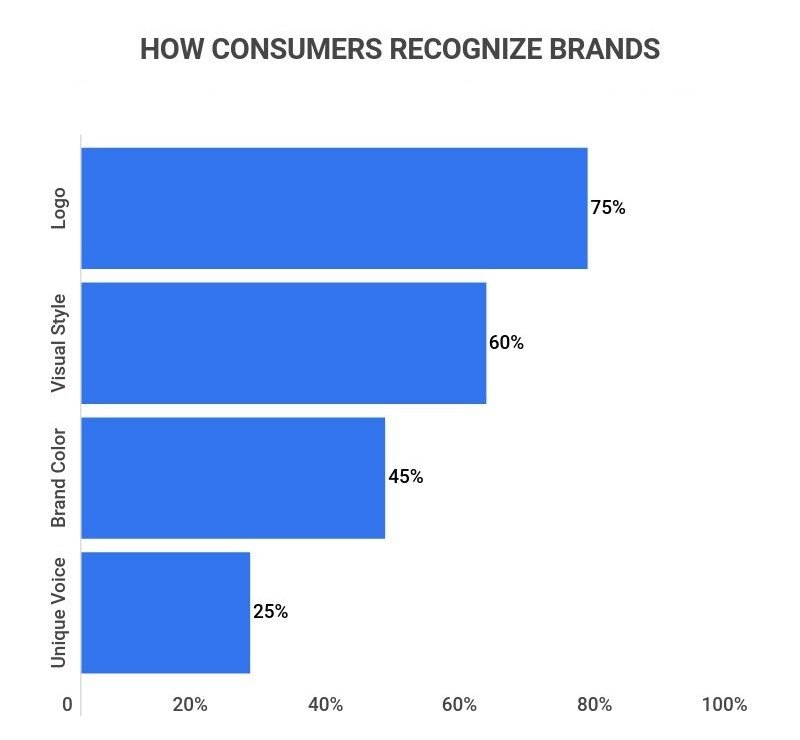Brand Identity: What it is and how to build one
Brand identity is the way a company presents itself to the world. It includes elements like the logo, colors, fonts, and overall design style. These elements work together to create a unique image that helps customers recognize and remember the brand.
Brand identity also reflects the values and personality of the company. It tells people what the brand stands for and how it differs from others. A strong brand identity builds trust and loyalty among customers, making it an important part of any successful business strategy.

What is Brand Identity?
A brand is how people perceive a person, product, or business. Brand identity is how a business wants to be seen. These ideas often align but can differ if a brand doesn’t manage its identity well.
Brand identity includes logos, fonts, colors, packaging, and messaging. The goal is to create a cohesive set of visual and written elements that reflect your brand’s purpose. A strong brand identity attracts new customers and makes current ones feel connected
The Difference Between Brand Identity and Brand Image
Brand identity and brand image are related but distinct concepts. Brand identity is how a company wants to be seen. It includes visual elements such as the logo, colors, and design style. These are carefully crafted to convey the brand’s values and mission.
On the other hand, brand image is how customers actually perceive the brand. It is shaped by their experiences, interactions, and the messages they receive. While a company controls brand identity, brand image is often influenced by external factors, such as customer reviews and media coverage.
In summary, brand identity is the intended image, while brand image is the reality as perceived by the audience.
What Makes a Good Brand?
A good brand stands out and connects with people. Here are the key things that make a brand good:
- Clear Purpose: It has a clear reason for existing and knows what it wants to achieve.
- Unique Identity: It has something special that makes it different from others.
- Consistent Image: It looks and feels the same everywhere, from its logo to its website.
- Strong Message: It communicates clearly and effectively with its audience.
- Good Reputation: It is known for being reliable and trustworthy.
- Emotional Connection: It makes people feel something and builds strong relationships.
- Quality Products or Services: It offers great products or services that meet customer needs
History of Brand Identity
Branding has a long history. In ancient Egypt, Greece, and Rome, merchants used signs with pictures to show what they were selling. This helped people who couldn’t read understand their offerings. The word “brand” comes from an old Norse word “brandr,” meaning “to burn.” This referred to the practice of burning marks into livestock to show ownership.
Symbols used by nations, religions, and groups, similar to today’s branding, have been around for thousands of years. In the 13th century, craft guilds started using marks to identify their goods and control trade. By the 1700s, trademarks and laws for patents, trademarks, and copyrights were introduced. During the Industrial Revolution, manufacturers began using logos to stand out from competitors.
In the 1800s, advertising agencies in England changed branding from simple logos to more complex strategies. This included special packaging, mascots, jingles, and other marketing techniques. Companies
Why is Brand Identity Important?
Many companies don’t realize how important it is to create a strong brand identity in their marketing plans. But it’s a key step.
Creating a brand identity helps bring a brand to life and form strong emotional bonds with its audience. A unique and clear identity sets a brand apart from competitors and helps build a lasting reputation.
Here are some benefits of a strong brand identity:
- Uniqueness: It highlights what makes the brand special and different from others.
- Emotional Connection: It helps build a personal connection with the audience.
- Consistency: It ensures that the brand’s message and image are the same everywhere, improving recognition.
- Clarity: It separates the brand’s core elements from ones that can change over time.
Brand identity is how a brand wants to be seen by consumers. This is different from brand image, which is how the brand is actually seen.
Some brands copy their competitors or follow short-term trends. This can make them look generic and weakens their connection with their audience. Imitating others or chasing trends doesn’t help in building a strong foundation for long-term success.
A strong brand identity helps entrepreneurs and brand strategists create an authentic image. Brands with a clear identity are confident about who they are and how they connect with their audience. In short, a strong brand identity gives brands an advantage and increases their chances of long-term success.
Imagine going to a job interview in sweatpants—you’d want to dress well to make a good impression. The same applies to your brand. Your brand identity is the face of your business, and it should present a polished image.
A consistent brand identity builds trust and shows what your brand is about. For example, Coca-Cola uses its classic red and white colors to convey a sense of tradition and happiness, while Nike uses a bold, simple logo and dynamic colors to suggest innovation and energy.
Brand identity also reflects the values and personality of the company. It tells people what the brand stands for and how it differs from others. A strong brand identity builds trust and loyalty among customers, making it an important part of any successful business strategy.
Seven Key Elements of a Brand’s Identity
Brand Story
A brand story is a unique and engaging narrative about where the brand comes from. It helps build a strong emotional connection with customers and makes the brand memorable. A good brand story can include:
- Why and when the brand was created
- Information about the founders
- Major events and milestones
- Cultural or historical details
- Interesting and inspiring moments in the brand’s history
Brand Name
The brand name is often the first thing people notice. It should be easy to remember, spell, and say. The name can be a mix of words, letters, or numbers. A strong brand name helps with recognition and can evoke feelings.
Brand Personality
Giving a brand a personality makes it more relatable. This personality reflects in how the brand behaves and what it values. It helps create a bond with the audience, similar to how people connect with other people. According to branding expert Jean-Noël Kapferer, “brand personality fulfills a psychological function. It allows consumers to either identify with it, or to project themselves into it.”
Communication Style and Tone of Voice
The brand’s communication style and tone of voice define how it talks to people. This includes the choice of words, how messages are delivered, and the emotions expressed. Key aspects include:
- Communication Style: How the brand communicates (e.g., formal or casual, energetic or calm).
- Tone of Voice: The mood of the brand’s communication (e.g., funny or serious, respectful or irreverent).
The Brand as a Product or Service
The brand’s products or services play a big role in its identity. Customers judge the brand based on what it offers, including quality, uniqueness, and impact. Products and services should reflect the brand’s identity and stand out in the market.
Visual Identity
The visual identity includes all the graphic elements that represent the brand. This includes:
- Color palette
- Logo
- Fonts and typefaces
- Imagery and photography style
- Design of products and packaging
Consistency in visual identity helps people recognize and trust the brand.
Sensory Identity
Sensory identity involves the senses like smell, touch, and sound. These elements can enhance the brand experience and leave a lasting impression. Sensory elements might include specific scents, sounds, or textures that create unique experiences and associations with the brand. While not always necessary, sensory identity can be important depending on the industry.
Three Examples of Strong Brand Identity Design

1. Hootsuite:
Hootsuite’s logo redesign brought in new colors and personality, making the brand feel more friendly and approachable. This change helped Hootsuite stand out in the crowded tech space. Source: Hootsuite

2. Kodak:
Kodak’s rebranding in 2006 saw the return of the big red “K” block. The updated logo with a fresh sans-serif font made a significant impact, proving that small changes can refresh a brand. Source: Kodak

3. Burt’s Bees:
In the beauty industry, Burt’s Bees stands out with its natural, down-to-earth branding. The muted colors and illustrations reflect the brand’s commitment to environmentally-friendly products. Source: Burt’s Bees
How to Build a Successful Brand Identity
Let’s explore the seven elements essential for a strong brand identity:
- Clear Purpose and Position
Your brand purpose is the reason your brand exists. It’s the “why” behind everything you do. For example, Apple’s purpose is “to make the best products on earth and leave the world better than we found it.” Source: Apple
Brand positioning is how you communicate this purpose. It’s your brand’s elevator pitch and the foundation for your logo, colors, and more.
- Market Research
Good market research helps you understand your audience and the cultural context your brand operates in. Talking to people, conducting surveys, and analyzing trends can inform your brand’s purpose and positioning. Tools like SurveyMonkey can be useful for gathering data. Source: SurveyMonkey
Customer personas—detailed profiles of your ideal customers—help you understand their needs and preferences, guiding your brand’s personality.
- Brand Personality
Consider your brand as a person. What would they be like? This personality should be evident in all your brand’s communications. For example, the casual and friendly tone of Innocent Drinks aligns with its brand personality. Source: Innocent Drinks - Memorable Logo
Your logo is central to your brand identity. It should be simple, memorable, and versatile. Disney’s logo, with its playful script, evokes magic and creativity. Source: Disney - Color Palette
Colors can evoke emotions. For instance, blue often represents calm and trust, while red signifies passion and energy. Ensure your color palette is consistent and appropriate for your brand’s message. Be mindful of cultural differences in color meanings. Source: Color Psychology - Typography
Fonts play a significant role in brand identity. Choose a primary typeface that complements your logo and colors. Keep it simple and readable. Examples of effective font pairings include Helvetica and Georgia. Source: Font Pairings - Graphics and Photography
Your brand’s visual language includes graphics, icons, and photos. Google’s visual guidelines show how consistent design elements make their brand instantly recognizable. Source: Google
- Clear Purpose and Position
Logo Recognition Stats
- Customers usually need to see a logo 5 to 7 times to remember it.
- A logo typically lasts about 10 years.
- In 2010, a study showed 69% of three-year-olds could recognize the McDonald’s logo.
- 88% of adults recognize the McDonald’s and Shell logos.
Consumer Logo Opinions
- 75% of people identify a brand by its logo.
- A logo is the most recognized brand element, followed by visual style (60%), brand color (45%), and unique voice (25%).

42% of consumers think a logo shows a brand’s personality well.
60% of consumers avoid brands with logos they find unattractive, even if the brand has good reviews.
78% of consumers view brand logos as works of art, highlighting the importance of logos in their buying decisions.
Maintaining Your Brand Identity
Once you have your brand identity elements, use brand guidelines to keep everything consistent. These guidelines help ensure that your brand is represented correctly across all materials. Customizable templates can also make it easier to create on-brand content quickly.
Key Takeaways
strong brand identity provides clarity and consistency. Over time, your unique brand will become the go-to solution for your audience’s needs. Ready to build your brand? Explore our brand template library today.
Article Sources
Nova Chicago asks writers to use reliable sources for their work. These include white papers, government data, original reports, and expert interviews. We also use research from trusted publishers when needed. You can find more about our rules for accurate and fair content in our editorial policy.
Are you Looking for brand identity design? Contact us
If you’re looking for a design agency that creates simple, iconic, and memorable visual identities, Nova Chicago is here to help. Let’s work together to craft a design strategy that attracts high-paying clients and sets your brand apart. Contact us today to start your journey toward unforgettable design.
Contact Us:
Nova Chicago is an Agency that helps businesses and personal brands attract high-paying clients through design and strategy.
- Email: Contact@novachicago.design
- Phone: +55 (84) 99854 3058
- Hours: Mon-Fri 9:00AM - 5:00PM
